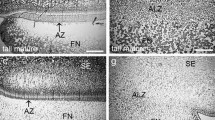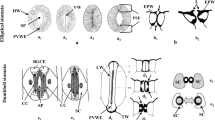Abstract
Monoclonal antibodies recognizing un-esterified (JIM5) and methyl-esterified (JIM7) epitopes of pectin have been used to locate these epitopes by indirect immunofluorescence and immunogold electron microscopy in the root apex of carrot (Daucus carota L.). Both antibodies labelled the walls of cells in all tissues of the developing root apex. Immunogold labelling observed at the level of the electron microscope indicated differential location of the pectin epitopes within the cell walls. The un-esterified epitope was located to the inner surface of the primary cell walls adjacent to the plasma membrane, in the middle lamella and abundantly to the outer surface at intercellular spaces. In contrast, the epitope containing methyl-esterified pectin was located evenly throughout the cell wall. In root apices of certain other species the JIM5 and JIM7 epitopes were found to be restricted to distinct tissues of the developing roots. In the root apex of oat (Avena sativa L.), JIM5 was most abundantly reactive with cell walls at the region of intercellular spaces of the cortical cells. JIM7 was reactive with cells of the cortex and the stele. Neither epitope occurred in walls of the epidermal or root-cap cells. These pattern of expression were observed to derive from the very earliest stages of the development of these tissues in the oat root meristem and were maintained in the mature root. In the coleoptile and leaf tissues of oat seedlings, JIM5 labelled all cells abundantly whereas JIM7 was unreactive. Other members of the Gramineae and also the Chenopodiaceae are shown to express similar restricted spatial patterns of distribution of these pectin epitopes in root apices.
Similar content being viewed by others
Abbreviations
- CDTA:
-
1,2-diaminocyclohexane tetraacetic acid
- RG:
-
rhamnogalacturonan
References
Albersheim, P., Mühlethaler, K., Frey-Wyssling, A. (1960) Stained pectin as seen in the electron microscope. J. Biophys. Biochem. Cytol. 8, 501–506
Bacic, A., Harris, P.J., Stone, B.A. (1988) Structure and function of plant cell walls. In: The biochemistry of plants. A comprehensive treatise, vol. 14: Carbohydrates, pp. 297–371, Preiss, J., ed. Academic Press, New York London
Bazin, H. (1982) Production of rat monoclonal antibodies with the LOU rat non-secreting IR983F myeloma cell line. Protides Biol. Fluids Proc. Colloq. 29, 615–618
Bonfante-Fasolo, P., Vian, B., Perotto, S., Faccio, A., Knox, J.P. (1990) Cellulose and pectin localization in roots of mycorrhizal Allium porrum labelling continuity between host cell wall and interfacial material. Planta 180, 537–547
Fry, S.C. (1983) Feruloylated pectins from the primary cell wall: their structure and possible function. Planta 157, 111–123
Fry, S.C. (1988) The growing plant cell wall: chemical and metabolic analysis. Longman, Harlow, UK
Fry, S.C. (1989) Analysis of cross-links in the growing cell walls of higher plants. In: Modern methods in plant analysis, N.S., vol. 10: Plant fibers, pp. 12–36, Linskens, H.S., Jackson, J.S., eds. Springer, Berlin Heidelberg New York
Jarvis, M.C. (1984) Structure and properties of pectin gels in plant cell walls. Plant Cell Environ. 7, 153–164
Jarvis, M.C., Forsyth, W., Duncan, H.J. (1988) A survey of the pectic content of nonlignified monocot cell walls. Plant Physiol. 88, 309–314
Knox, J.P., Day, S., Roberts, K. (1989) A set of cell surface glycoproteins forms an early marker of cell position, but not cell type, in the root apical meristem of Daucus carota L. Development 106, 47–56
McNeil, M., Darvill, A.G., Fry, S.C., Albersheim, P. (1984) Structure and function of the primary cell walls of plants. Annu. Rev. Biochem. 53, 625–663
Moore, P.J., Staehelin, A. (1988) Immunogold localization of the cell wall matrix polysaccharides rhamnogalacturonan I and xyloglucan during cell expansion and cytokinesis in Trifolium pratense L.; implication for secretory pathways. Planta 174, 433–445
Moore, P.J., Darvill, A.G., Albersheim, P., Staehelin, L.A. (1986) Immunogold localization of xyloglucan and rhamnogalacturonan I in the cell walls of suspension-cultured sycamore cells. Plant Physiol. 82, 787–794
Moustacas, A-M., Nari, J., Diamantidis, G., Noat, G., Crasnier, M., Borel, M., Ricard, J. (1986) Electrostatic effects and dynamics of enzyme reactions at the surface of plant cells. 2. The role of pectin methyl esterase in the modulation of electrostatic effects in soybean cell walls. Eur. J. Biochem. 155, 191–197
Nari, J., Noat, G., Diamantidis, G., Woudstra, M., Ricard, J. (1986) Electrostatic effects and dynamics of enzyme reactions at the surface of plant cells. 3. Interplay between limited cell wall autolysis, pectin methylesterase activity and electrostatic effects in soybean cells. Eur. J. Biochem. 155, 199–202
Pennell, R.I., Knox, J.P., Scofield, G.N., Selvendran, R.R., Roberts, K. (1989) A family of abundant plasma membrane-associated glycoproteins related to the arabinogalactan proteins is unique to flowering plants. J. Cell Biol. 108, 1967–1977
Powell, D.A., Morris, E.R., Gidley, M.J., Rees, D.A. (1982) Conformations and interactions of pectins. II. Influence of residue sequence on chain association in calcium pectate gels. J. Mol. Biol. 155, 517–531
Redgwell, R.J., Selvendran, R.R. (1986) Structural features of the cell wall polysaccharides of onion Allium cepa. Carbohydr. Res. 157, 183–199
Roldan, J.C., Vian, B. (1981) Use of purified endopolygalacturonase for a topochemical study of elongating cell walls at the ultrastructural level. J. Cell Sci. 48, 333–343
Schols, H.A., Reitsma, J.C.E., Voragen, A.G.J., Pilnik, W. (1989) High performance ion exchange chromatography of pectins. Food Hydrocolloids 3, 115–121
Selvendran, R.R. (1986) Developments in the chemistry and biochemistry of pectic and hemicellulosic polymers. J. Cell Sci., Suppl. 2, 51–88
VandenBosch, K.A., Bradley, D.J., Knox, J.P., Perotto, S., Butcher, G.W., Brewin, N.J. (1989) Common components of the infection thread matrix and the intercellular space identified by immunocytochemical analysis of pea nodules and uninfected roots. EMBO J. 8, 335–342
Vreeland, V., Laetsch, W.M. (1989) Identification of associating carbohydrate sequences with labelled oligosaccharides. Localization of alginate-gelling subunits in cell walls of a brown alga. Planta 177, 423–434
Vreeland, V., Morse, S.R., Robichaux, R.H., Miller, K.L., Hua, S-S.T., Laetsch, W.M. (1989) Pectate distribution and esterification in Dubautia leaves and soybean nodules, studied with a fluorescent hybridization probe. Planta 177, 435–446
Author information
Authors and Affiliations
Additional information
J.P.K. was supported by the Agricultural and Food Research Council Cell Signalling and Recognition Programme. We thank J. Cooke and N. Stacey for technical assistance, H.A. Schols, Drs. P. Albersheim and A. Darvill for pectic polysaccharides, and Dr. R.R. Selvendran and M. McCann for useful discussions.
Rights and permissions
About this article
Cite this article
Knox, J.P., Linstead, P.J., King, J. et al. Pectin esterification is spatially regulated both within cell walls and between developing tissues of root apices. Planta 181, 512–521 (1990). https://doi.org/10.1007/BF00193004
Accepted:
Issue Date:
DOI: https://doi.org/10.1007/BF00193004




